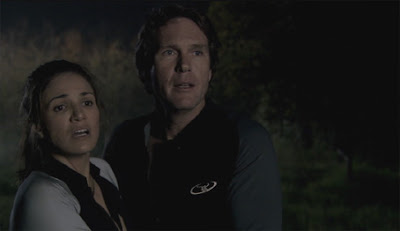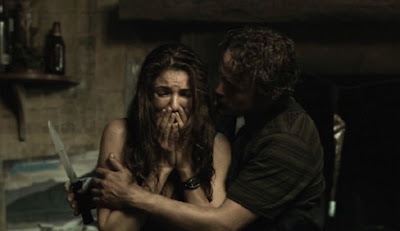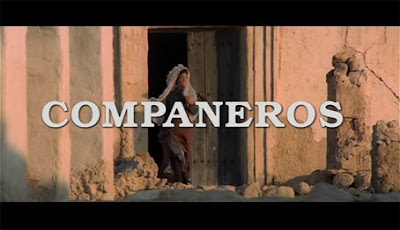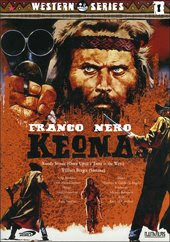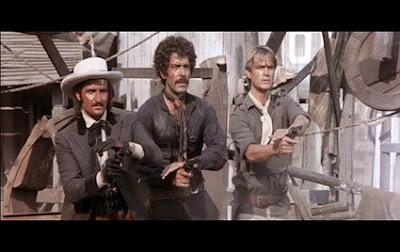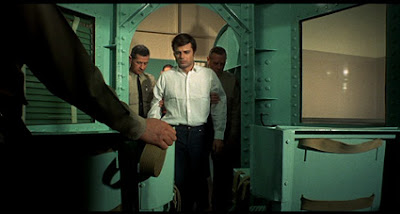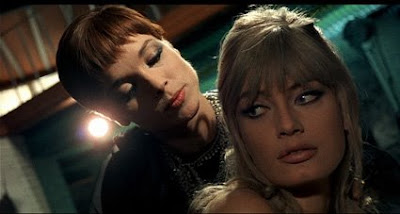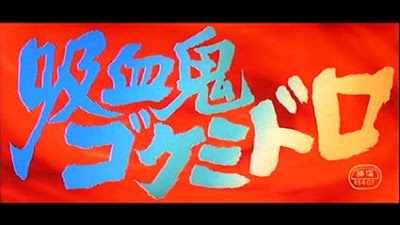
 The Devil Rides Out
The Devil Rides OutDirected by: Terrence Fisher
UK, 1968
Horror / Hammer / Satanism, 96min
Distributed by: Anchor Bay Entertainment.
Story:
When young Simon gets seduced by a Satanic cult, it’s up to his guardian Duc De Richeleau to save him from the talons of evil. After entering Simon’s house late at De Richleau finds evidence of satanic rituals and is confronted by a demonic presence. At the same time Simon disappears mysteriously from the safety of Du Richleau’s mansion, forcing him to go up against the Satanic forces that have mesmerized Simon. A battle that cult leader Mocata does not fear at all, as he promises De Richeleau and friends while leaving them after a visit, that he will not return to their house, but “something” will come during the night…

Me:
Hammer, hammer, hammer. I love hammer movies, I started wathing them when I was a little lad, I used to read illustrated versions of their movies in the House of Hammer comics, I used to go home from parties just to fall asleep to late night airings of Hammer movies when I was studying at university. And thanks to home video and DVD there’s always been a decent selection of Hammer titles in my library so that when the urge hits me I can pop one of those fabulous movies in and fall asleep before it reaches midpoint. But this in now way means that Hammer movies are bad movies, quite the opposite. They are great movies well worth re-watching on more than one occasion.

The Devil Rides Out is a great example of Hammer on top of their game, you really can’t go wrong with Terrence Fisher directing perhaps one of his finest Hammer movies, with a screenplay by genre legend Richard Matheson, based on a book by Dennis Wheatley, grand master of the occult novel, and to top it off with Christopher Lee in the leading role and a great James Bernard score. That’s a set up that warrants a great movie. And it is, The Devil Rides Out is a fantastic movie, and in every way the antithesis of To the Devil a Daughter, the Wheatley/Lee/Hammer movie that bashed the final nail into Hammer's coffin some ten years later.

The Devil Rides Out sees Christopher Lee in the role of Duc De Richleau, a role he plays to perfection, and I’m quite positive that there’s more of Mr. Lee in this character than in his many portrayals of Count Dracula. De Richleau is a wealthy gent who together with Rex Van Ryn [Leon Greene] have promised to take care and act as guardians for younger upper-class chap Simon [Patrick Mower] (Although he looks old enough to take care of himself…) This leads to them arrogantly interrupting a party which they soon understand by the clumsy slip of the tongues the guests make, is in fact a party for the Satanists! As Simon tries to explain that the party is for invited guests only De Richleau forcefully lingers in the house, and as Simon politely shows them the door, De Richleau demands to take a look at Simon's attic observatory so that he can take a look at the stars. In the observatory he finds what he’s looking for, two sacrificial chickens, he’s proven his point and now because of the promise made to Simons father, has to save min from the satanic cult. This leads to the introduction of the secondary cast and the lead antagonist, the satanic cult lead by Mocata excellently played by Charles Gray [Possibly most know for playing James Bond’s nemesis Blofield in Diamonds are Forever in 1971 and the 1975 cult fave The Rocky Horror Picture Show where he’s the “Criminologist” and narrator of the movie]. After sneaking up on the secret Sabbath in the forest, racing their car and throwing a cross at the devil himself making him go up in a cloud of smoke to the horror of the Satanists, they snatch Simon and Rex’s love interest, Tanith with them. Tanith [Nike Arrighi] who also is a prospect awaiting initiation into the Satanists coven Then the movies shifts up a gear as Richleau and friends battle the various evil apparitions sent before them, giant spiders, fake incarcerations of the Eaton’s daughter Peggy, and the Angel of Death himself!
 Needless to say all other characters are out acted by Lee who surely gives one of his all time best performances here, and he probably does this as he had a personal interest in the movie. Being fed up with playing the Count and the way the Dracula movies where going, he insisted that Hammer buy the rights to his acquaintance Dennis Wheatly’s novels. Said and done that’s just what they did, and this time around they made a damned good job out of it, but the next time, in the diabolical To the Devil a Daughter (worth watching only for Lee’s depraved satanic priest and a young Nastassja Kinski) they got it all wrong and bailed out halfway through making it a terrible movie and the one that sadly became the final movie released from that great studio.
Needless to say all other characters are out acted by Lee who surely gives one of his all time best performances here, and he probably does this as he had a personal interest in the movie. Being fed up with playing the Count and the way the Dracula movies where going, he insisted that Hammer buy the rights to his acquaintance Dennis Wheatly’s novels. Said and done that’s just what they did, and this time around they made a damned good job out of it, but the next time, in the diabolical To the Devil a Daughter (worth watching only for Lee’s depraved satanic priest and a young Nastassja Kinski) they got it all wrong and bailed out halfway through making it a terrible movie and the one that sadly became the final movie released from that great studio. Although Hammer films always where shot on tight budgets, short schedules, reoccurring actors and the same locations they always made movies that looked great. Period clothing, wonderful mattes, suggestive effects all work wonders, but among the most impressive production design in The Devil Rides Out is the amazing amount of period vehicles they rallied up for the shoot. Set in the 1920’s they manage to conjure up somewhere in the vicinity of fourteen various automobiles from that time period. Really an impressive feat considering the tight budgets that they shot these movies on. They could have made do with one or two cars, but no, every Satanist has to have on for that drive out into the forest. Also The Devil Rides Out is one of the first movies to actually deal with Satanism, Black Magic and the contemporary battle between Good and Evil in a serious approach, which possibly could be part of the reason that the ending comes all too easy, kind of sudden, somewhat confusing and really could have been better. But all in all if you get that far you will probably accept Christopher Lee’s cheesy explanation when he answers Simon’s question, But what happened? The Devil Rides out is a highly entertaining and a great movie, not to say one of Hammer’s best movies outside of their trademark Gothic Horrors.
Although Hammer films always where shot on tight budgets, short schedules, reoccurring actors and the same locations they always made movies that looked great. Period clothing, wonderful mattes, suggestive effects all work wonders, but among the most impressive production design in The Devil Rides Out is the amazing amount of period vehicles they rallied up for the shoot. Set in the 1920’s they manage to conjure up somewhere in the vicinity of fourteen various automobiles from that time period. Really an impressive feat considering the tight budgets that they shot these movies on. They could have made do with one or two cars, but no, every Satanist has to have on for that drive out into the forest. Also The Devil Rides Out is one of the first movies to actually deal with Satanism, Black Magic and the contemporary battle between Good and Evil in a serious approach, which possibly could be part of the reason that the ending comes all too easy, kind of sudden, somewhat confusing and really could have been better. But all in all if you get that far you will probably accept Christopher Lee’s cheesy explanation when he answers Simon’s question, But what happened? The Devil Rides out is a highly entertaining and a great movie, not to say one of Hammer’s best movies outside of their trademark Gothic Horrors.Image:
Spherical 1.66:1 here presented in 16x9 Anamorphic
Audio:
DolbyDigital 5.1, Dolby Surround 2.0 and French Mono. No subtitles available.
Extras:
Well I’ve chosen to go for the US (out of print) version, as the version included in “The Ultimate Hammer Collection” lacks the extras featured on the overseas release. The extras on the US version are: An interesting and informative commentary track featuring Christopher Lee, Sarah Lawson and Marcus Hearn co-author of The Hammer Story, Theatrical trailers for the film, both US and UK versions, and then there’s the documentary. This is where the Anchor Bay edition make’s it worth the purchase as they enhanced each release with a thematically linked edition of the documentary series World of Hammer. Each episode dedicated to showcasing the best of Hammer and all narrated by former Hammer star Oliver Reed. This episode is the HAMMER episode and tells the story of this magnificent production company.
Although the US single movie edition is Oop, there is a great release available which features not only The Devil Rides Out, but also Don Sharp’s 1966 Hammer movie Rasputin : The Mad Monk, with yet another great Christopher Lee performance.



